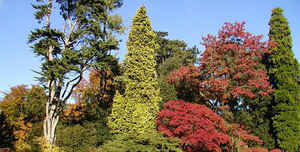
Vermont Symbols
Vermont State Tree
Sugar Maple
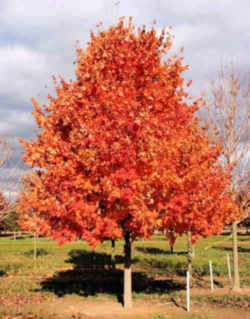
(Aceraceae Acer saccharum)
Adopted on March 10, 1949.
The sugar maple tree, (Aceraceae Acer saccharum,) became the official tree of Vermont through Senate Bill No. 3, approved by the Vermont State Legislature and signed by Governor Ernest W. Gibson, Jr.
Sometimes called hard maple or rock maple, sugar maple is one of the largest and more important of the hardwoods. Sap from the trunks of sugar maples is used to make maple syrup. Sugar maple trees seldom flower until they are at least 22 years old, but they can also live 300 to 400 years.
Vermont State Tree: Sugar Maple
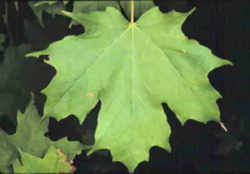
Vermont shares its state tree, the sugar maple, with New York, West Virginia, Wisconsin, and Canada. A single tree is 70-120 feet high and produces two to three pounds of sugar when "sugared-off." It has a five-lobed leaf and a small wing-shaped seed pod. In the fall the leaves turn bright yellow.
The leaves on the sugar maple turn red and yellow in the fall. These trees add to Vermont's beautiful fall foliage. This is also the tree that produces the sap for making maple syrup and maple sugar.
For hundreds of years, people have gathered the sap in the early spring.The sap is boiled to remove the water. In the past, most of the sap was used to make maple sugar. Now a lot of the sap is used to make maple syrup.
Identification of the Sugar Maple
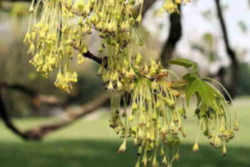
Sugar maple (Acer saccharum), sometimes called hard maple or rock maple, is one of the largest and more important of the hardwoods. It grows on approximately 12.5 million hectares (31 million acres) or 9 percent of the hardwood land and has a net volume of about 130 million m3 (26 billion fbm) or 6 percent of the hardwood sawtimber volume in the United States. The greatest commercial volumes are presently in Michigan, New York, Maine, Wisconsin, and Pennsylvania (53). In most regions, both the sawtimber and growing stock volumes are increasing, with increased production of saw logs, pulpwood, and more recently, firewood.
- Leaf: Opposite, simple and palmately veined, 3 to 6 inches long, 5 lobed with entire margin; green above, paler below.
- Flower: Yellow to green, small, clustered, hanging from a long (1 to 3 inch) stem, appearing with the leaves. The flowers are in corymbs of five to 10 together, yellow-green and without petals; flowering occurs in early spring after 30-55 growing degree days. The sugar maple will generally begin flowering when it is between 10 to 15 years old.
- Fruit: The fruit is a two-winged horseshoe-shaped samaras about 1 inch long, appearing in clusters, brown when mature in Autumn.
- Twig: Brown, slender and shiny with lighter lenticels, terminal buds brown and very sharp pointed.
- Bark: Variable, but generally grayish brown,on older trees may be furrowed, with long, thick irregular curling outward ridges.
- Form: Medium to tall tree (to 100 feet) with very dense elliptical crown.
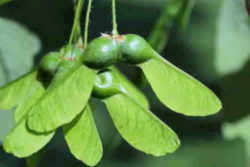
Adoption of Sugar Maple
No. 1 of the Acts of 1949, effective March 10, 1949, designated the Sugar Maple, Aceraceaecer Acer saccharumas the official Tree. Probably no activity is so identified with Vermont as ", as the official Tree. Probably no activity is so identified with Vermont as "sug'rin" the production of maple syrup from the Sugar Maple. In late winter and early spring, sap is collected from the usually snow surrounded maple trees in a'," the production of maple syrup from the Sugar Maple. In late winter and early spring, sap is collected from the usually snow surrounded maple trees in a sugarbushnd boiled in the sugarhouse to make syrup. In addition, the reds and yellows of the leaves of Acerand boiled in the sugarhouse to make syrup. In addition, the reds and yellows of the leaves of Acer saccharumre a key element in producing the scenic delights of Vermont's fall foliage.are a key element in producing the scenic delights of Vermont's fall foliage.
Vermont Law
The law designating the Sugar Maple, as the official Vermont state tree is found in the Vermont Statutes, Title 1 Chapter 11, Section 499.
The Vermont Statutes Online
Title 1: General Provisions
Chapter 11: Flag, Insignia, Seal, Etc.
499. State tree
499. State tree
The state tree shall be the sugar maple.
Taxonomic Hierarchy: Sugar Maple
Kingdom: Plantae - Plants
Subkingdom: Tracheobionta - Vascular plants
Superdivision: Spermatophyta - Seed plants
Division: Magnoliophyta - Flowering plants
Class: Magnoliopsida - Dicotyledons
Subclass: Rosidae
Order: Sapindales
Family: Aceraceae - Maple family
Genus: Acer L. - maple
Species; Acer saccharum Marshall - sugar maple






